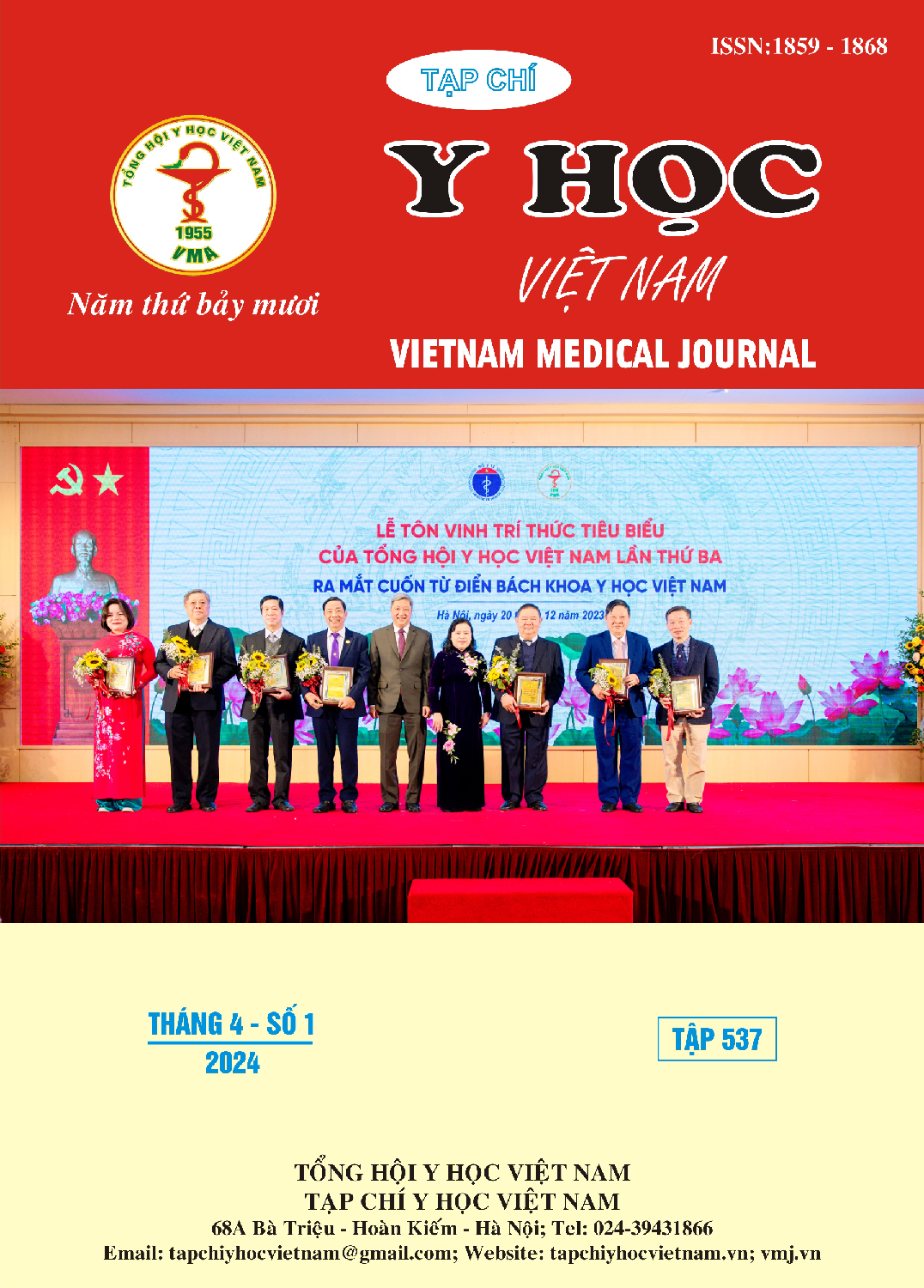THE PREDICTIVE VALUE FOR MORTALITY OF D-DIMER IN SEVERE COVID-19 PATIENTS TREATED AT NATIONAL HOSPITAL FOR TROPICAL DISEASES, PERIOD 2021-2023
Main Article Content
Abstract
A retrospective study on 144 severe COVID-19 patients over 18 years old admitted to the National Hospital for Tropical Diseases from 2021 to 2023 to investigate the predictive value for mortality of D-dimer in severe COVID-19. Results: The mortality rate was 27.1% among the study participants. The median D-dimer concentration exhibited a gradual increase during the treatment period, reaching 1170.5 ng/mL (IQR 605-2573) at admission, 1247 ng/mL (IQR 754-2437) on day 3, 1549 ng/mL (IQR 983-2609.5) on day 7, and 1637 ng/mL (IQR 849-3968.7) on day 14. Notably, the median D-dimer concentration in the non-survivor group was significantly higher than that in the survivor group on days 7 and 14, with D-dimer levels reaching 1848.5 ng/mL (IQR 1209-3882.8) and 2672 ng/mL (IQR 1513.8-14743.8), respectively, compared to 1417 ng/mL (IQR 707-2449) and 1372 ng/mL (IQR 768.3-1997.5). Additionally, patients with D-dimer levels exceeding 6042.5 ng/mL at admission and 3300.5 ng/mL on day 3 exhibited a significantly lower survival rate than those with lower D-dimer levels (p<0.05, log-rank test). Among the different time points evaluated, D-dimer levels measured on day 14 demonstrated the best predictive value for mortality, with an area under the curve (AUC) of 0.724 (CI 95% 0.63-0.82). The optimal cutoff value for D-dimer on day 14 was determined to be 1587.5 ng/mL, with a sensitivity of 58.7% and a specificity of 76.3%. Conclusion: In severe COVID-19 patients, repeated measuring of D-dimer levels, particularly on days 7 and 14 after hospital admission, can provide valuable information to clinicians for monitoring patients and optimization of treatment regimens.
Article Details
Keywords
Severe COVID-19, D-dimer, prognosis, mortality.
References
2. Bộ Y tế. Quyết định 2671/QĐ-BYT, ngày 26/06/2023 ban hành kèm Hướng dẫn chẩn đoán và điều trị COVID 19..
3. Yao Y, Cao J., Wang Q., et al. D-Dimer as a Biomarker for Disease Severity and Mortality in COVID-19 Patients: A Case Control Study, J Intensive Care (2020), 8, 49, https://doi.org/10.1 186/s40560-020-00466-z.
4. Iba T, Levy J.H, Levi M., Thachil J. Coagulopathy in COVID-19, J Thromb Haemost (2020), 18 (9), 2103-2109.https://doi.org/10. 1111/jth,14975.
5. Zhan H., Chen H, Liu C, Cheng L, et al. Diagnostic Value of D-Dimer in COVID-19: A Meta-Analysis and Meta-Regression, Clin Appl Thromb Hemost (2021), 27. 10760296211010976. https://doi.org/10.1177/10760296211010976.
6. Guan WJ, Ni ZY, Hu Y, et al. Clinical Characteristics of Coronavirus Disease 2019 in China. N Engl J Med. (2020) 382:1708–20. doi: 10.1056/NEJMoa2002032).
7. Trường Cao Vân, Hùng Thân Mạnh, Nam Lê Văn. Đặc điểm lâm sàng, cận lâm sàng viêm phổi thở máy ở bệnh nhân COVID-19 tại Bệnh viện Bệnh Nhiệt đới Trung ương (4/2021-3/2022). Tạp chí Y học Việt Nam (2022), Tập 519, tháng 10, số 2. DOI: https://doi.org/10.51298/vmj. v519i2.3622
8. Lan Lê Thị Hương, Thiện Nguyễn Thị Minh. Đặc điểm xét nghiệm huyết học và tình trạng tăng đông ở bệnh nhân COVID-19 tại Trung tâm hồi sức tích cực Long An năm 2021. Tạp chí Khoa học và Công nghệ Đại học Thái Nguyên (2022), T227, S. (10).DOI: https://doi.org/10.34238/tnu-jst.6031
9. Tuấn Phạm Minh, Giang Trần Văn, Thạch Phạm Ngọc. Đặc điểm lâm sàng, cận lâm sàng và các yếu tố tiên lượng tử vong bệnh nhân COVID-19 mức độ nặng, nguy kịch. Tạp chí Y học Việt Nam (2022), Tập 518 Số 1.https://doi.org/ 10.51298/vmj.v518i1.333
10. Poudel A., Poudel Y., Adhikari A., et al. D-Dimer as a Biomarker for Assessment of COVID-19 Prognosis: D-Dimer Levels on Admission and Its Role in Predicting Disease Outcome in Hospitalized Patients with COVID-19. PLoS One (2021), 16 (8), e0256744. https://doi.org/ 10.1371/journal.pone.0256744.


